Garmin | Firstbeat Physiology Insights – A Detailed Look at Each One
You get all of this clever stuff thrown into your top-end Garmin watch – as shown in the image from Firstbeat. And it is clever. I’ll talk about the more interesting features further below in more detail.
Be mindful that optical HR from the wrist might cause issues with the accuracy of the data that Firstbeat has to deal with as might incorrect input data of any sort (power, pace, etc). Any HR data inaccuracies should be rectified by a chest strap and most newish chest straps should also produce HRV data that some of the Firstbeat algorithms like/need in any case.
Recommended: Garmin Fenix 7 Review
I’ll talk a bit more about some of these features below and much of this section of the content is co-authored by HB at Firstbeat. ie it should be correct 😉
Garmin Real-Time Performance Condition – an explainer
 Like the analysis behind VO2max, Performance Condition looks at the relationship between your running speed (or cycling power) and heart rate. You are sometimes prompted with your Performance Condition about 5 or 6 minutes into a run but you can also display it continuously as a data metric and/or analyse it afterwards.
Like the analysis behind VO2max, Performance Condition looks at the relationship between your running speed (or cycling power) and heart rate. You are sometimes prompted with your Performance Condition about 5 or 6 minutes into a run but you can also display it continuously as a data metric and/or analyse it afterwards.
Using your VO2max as a baseline, Performance Condition tells you how your current run is stacking up to expectations. Early in your run, your Performance Condition is likely to reflect on your level of recovery or a handful of external factors. As your run progresses, decreases in Performance Condition will likely match up with the onset of fatigue and your body working harder to keep pace with your fresher self.
Further below we have a long Z2/Z3 hour bike ride (based on power meter data) following a swim. I’m not sure if this is how a Performance Condition chart is meant to be. 4 hours seem to mark a turning point in performance as fatigue sets in.


Here a different run is taken from CONNECT. I’m not sure you can infer anything from it. My performance condition definitely reflected that I started to struggle after about an hour due to a heavy week although my power and HR levels stayed in sync.

- Firstbeat Factette: The first Garmin device with Performance Condition was the Forerunner 630 (2015)
- You might choose to monitor PC during a run or ride and ‘go for it’ when PC values are positive. As the PC figures decline throughout a session then you might get to the point where you curtail the hard stuff.

- When values at the start of a run/ride are more extreme, say +6 or -6, then for me, they clearly reflect my feeling about my own readiness. However, as values hover between +/-2 then I’m not sure I can read too much into the data.
- I usually notice a warming-up factor where it takes a while for PC to peak. I’m not so sure it’s meant to do that.
Usefulness?: 7/10. It’s one of those ‘interesting things’ that pops up which you might occasionally take into account as your workout progresses. I haven’t yet got much back from looking at this bit of data trended over a run/ride in realtime and I’m not yet convinced about its true accuracy.
Garmin Training Status – An Explainer
 I’ve got to like this dashboardesque feature the more I glance at it. It combines the insights of Training Load and VO2max to reveal the relationship between your activities and your personal fitness level. The feedback it offers gives you the ability to evaluate the effectiveness of your programs and routines, understand where you are in a training cycle, and learn how your body responds.
I’ve got to like this dashboardesque feature the more I glance at it. It combines the insights of Training Load and VO2max to reveal the relationship between your activities and your personal fitness level. The feedback it offers gives you the ability to evaluate the effectiveness of your programs and routines, understand where you are in a training cycle, and learn how your body responds.
If you are following a proper training plan geared towards a specific race then Training Status may be a good check of how well the plan is working for you.
If ‘Peaking’ unexpectedly appears, get down to your local parkrun promptly and run really fast 😉

- Firstbeat Factette: The first Garmin devices with Training Status were the Fenix 5 & Forerunner 935 (2017)
Usefulness?: 7/10. It’s kinda interesting to see what Firstbeat think. But, to me, the usefulness of this stat comes in more as an alerting mechanism eg if my fitness or load were falling when my plan says they should not be. That rarely happens but when it does it is important to promptly address it. Perhaps if you were ‘randomly training’ and not following a plan then this might be a much more useful feature.
Garmin Recovery Time Advisor – An Explainer
Another EPOC-based metric, Recovery Time looks at the degree of homeostasis disturbance resulting from your most recent effort combined with the amount of time remaining on your recovery clock to predict when your body will have completed the work or restoration and adaptation. One popular misconception regarding Recovery Time feedback is that it should hit zero before your next session. What it’s really telling you is how long it will be before your body is ready to benefit from a tougher, fitness improving, workout. What’s a fitness-improving workout? Essentially we’re talking about sessions with an Aerobic Training Effect of 2.5 and above. Lighter efforts are a good way to promote recovery, as long as you don’t overdo it.
Recovery Time estimates have been updated for the Fenix 6 based on the latest sports science. This means adjustments are made based on your acute/chronic training load ratios and additional care is given to ensure adequate recovery after workouts that produce Training Effect scores that significantly exceed those of your normal training efforts.

.
This will usually pop up at the end of your run. It will NOT be stored in your workout history as, for example, one hour later your recovery time will have changed.
- Firstbeat Factette: The first Garmin device with Recovery Time was the Forerunner 620 (2014)
Usefulness? 9/10 I don’t treat this measure as the ‘truth’ but I certainly take it into account when training frequently. For example, if I do an evening workout and I get a recovery time of 21 hours then I may delay any workout scheduled for the following morning. For the sake of a 5-second glance at the end of your workout, this is 5 seconds well-spent. You can always ignore what it says
VO2max – An Explainer
A higher VO2max makes sport AND THE PHYSICAL RIGOURS OF LIFE easier. Sometimes us sporty people forget that.

VO2max is a relatively definitive metric of fitness. Improving it should indicate you are potentially faster but, critically, it does not take into account the economy of your technique. So we could both have a RUNNING VO2max of 60 but if your running gait is more efficient than mine then it’s very likely you’ll beat me in a 5k.
Maintaining your VO2max can also reduce the physiological impact of stress, makes it easier to recover, and can help stave off the effects of ageing.
I am somewhat intrigued why Garmin/Fristbeat display daily trends of VO2max. For me, these values can vary quite a bit…say by 5 percentage points. This clearly DOES NOT reflect the reality of what my VO2max actually is, as VO2max is a relatively slowly changing state. So, perhaps, what Fristbeat/Garmin are showing is my effective performance stated in VO2max equivalence terms??? IDK.
You can’t generally do anything with VO2max. It’s a marker of your progression or badge of honour, depending on how you want to see it. Whilst Garmin says the high 50s are ‘superior’, really I would say decent athletes will generally have values in the high 60s – or higher.
- Firstbeat Factette: The first Garmin Device with VO2max detection was the Forerunner 620 (2013)
Usefulness? 5/10. In itself, I would take this measure with a pinch of salt until it stabilises after a few weeks. Even then it’s pointless to regularly look at BUT perhaps helpful to know when a specific workout indicates you are performing at a higher/PB VO2max level. The REAL usefulness of these measures is that a lot of the other Firstbeat stuff is derived from it.
Heat & Altitude Acclimatization – VO2max & TRAINING STATUS adjustments
The impact of environmental factors is brought into focus with the addition of acclimatization tracking. You will be able to watch as your physiology adapts to help you perform better in higher elevations or in ways that help you manage the effects of hotter, more humid climates. This information is also factored into your performance analytics so that a decrease in performance capability attributable to your environment isn’t mistakenly attributed to unproductive training activities or poor recovery.
You will not normally see temperature acclimation or altitude acclimatisation unless you stray above 22ºC (72ºF) or an altitude of 800 m (2625 ft.) – 4000m. The altitude readings are triggered by your Fenix 6 but the temperatures are triggered from weather services via your Connect app.
You can see the SUN icon indicating that temperature acclimation is active. Full adaptation to these conditions will take you at least 4 days.
In these conditions, your VO2max and TRAINING STATUS screen, further below, are slightly modified.
Usefulness? 6/10: I can see how this feature might be useful to a select number of athletes who specifically use altitude training. Perhaps more useful to mere mortals will be heat acclimation for hot summer races?
Garmin Training Effect – An Explainer
The two Training Effect metrics are important and, in my experience, they seem to reflect well the session I’ve just completed.
Aerobic training Effect
 The further away from race day you are and the longer your race is to be then the more important achieving a high AEROBIC training effect is. Typically you will see the effect from the whole workout at the end of the workout and the screens are shown below will also be stored in your workout history on the watch.
The further away from race day you are and the longer your race is to be then the more important achieving a high AEROBIC training effect is. Typically you will see the effect from the whole workout at the end of the workout and the screens are shown below will also be stored in your workout history on the watch.
To progress and improve, you need to challenge yourself in the right way and at the right level. Aerobic Training Effect analyzes your performance to reveal the impact of your activity on the development of your cardio-respiratory system. The fitter and more active you are, the harder you need to work to improve. Behind the scenes, your watch takes this information into account to ensure that the Aerobic Training Effect feedback you get always reflects your own personal situation. Note: prior to the introduction of Anaerobic Training effect in 2017, Aerobic Training Effect was simply called Training Effect.
- Firstbeat Factette: The first Garmin device with (Aerobic) Training Effect was the Forerunner 610 (2011, TE)
- TE can also be shown as an accumulating metric throughout your workout. Other vendors (eg Suunto) have introduced adaptive workouts that target TE goals and curtail the workout once you have achieved the goal.
Anaerobic Training Effect
A powerful metric, this analysis reveals the impact of your activity on the development of anaerobic performance capacity. A lot of the confusion surrounding Anaerobic Training Effect comes from the fact that it doesn’t necessarily have much to do with how much time you spend in what some people refer to as the anaerobic heart rate zone (>LTHR/AnT/LT2/Z4). Instead, Anaerobic Training Effect is designed to accumulate when you challenge yourself with sustained bursts of intense effort interspersed with lower intensity efforts that give your body a chance to recover. HIIT sessions are a great way to register a higher Anaerobic Training Effect score, especially when the intervals performed focus on efforts in excess of your VO2max.
- Firstbeat Factette: The first Garmin device with Anaerobic Training Effect was the Fenix 5 (2017)
Training Effect & Workout Labels
The two Training Effect measures are combined on one summary screen to which is added the WORKOUT LABEL (shown as TEMPO in the image below, in orange). And then there are further screens (not shown) where a little more commentary is added about each training effect.
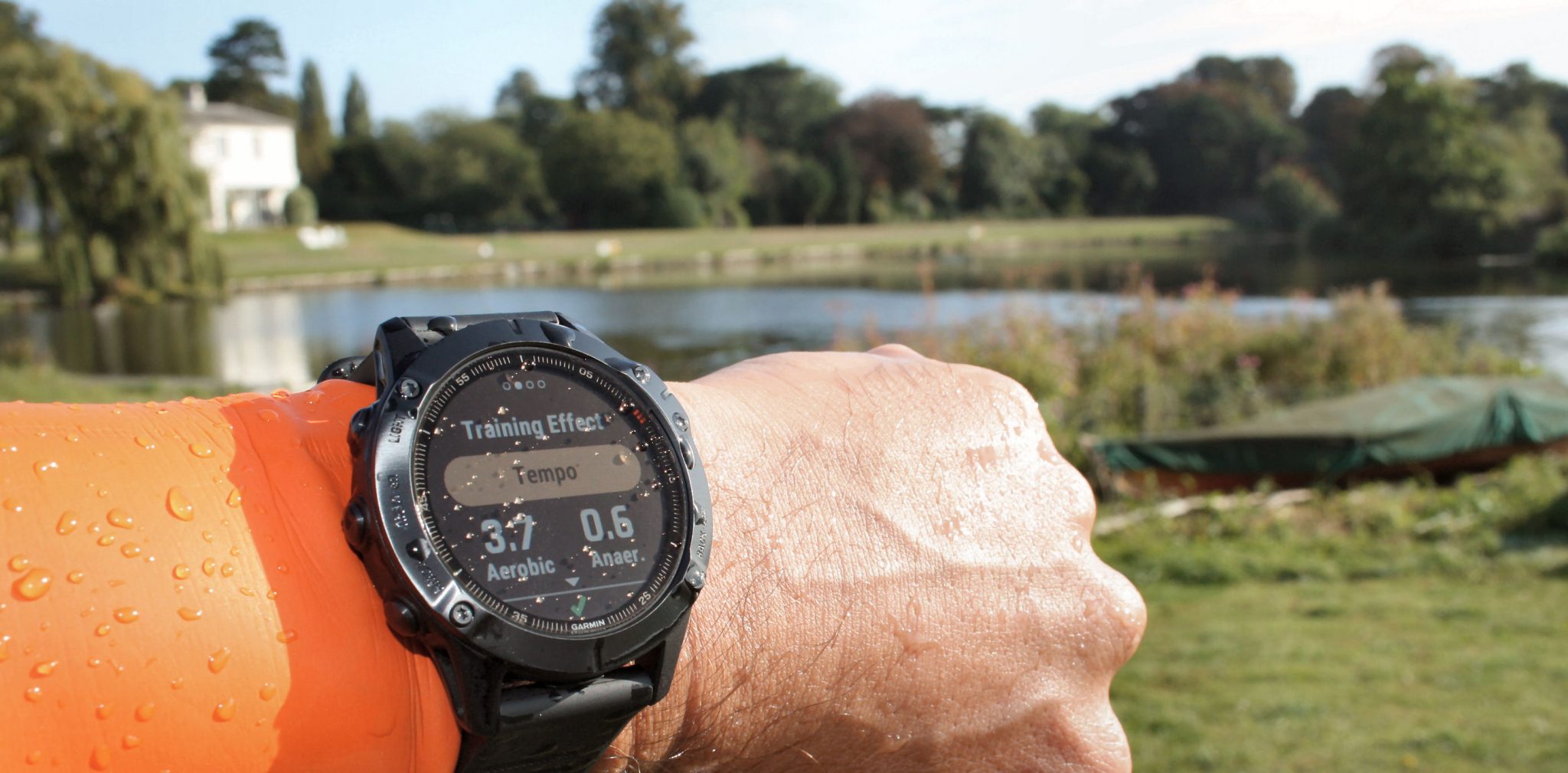
Usefulness? 9/10: I really like these screens and the data they give. The three metrics AnTE, AeTE and Workout labels give me a NICE summary of my workout. Sure it usually coincides with how I feel and what I know I have planned to do but sometimes it’s just nice to have someone else agree with you 😉 If anything the workout feedback tells me that the session should feel easier than what it did…aka I’m not trying hard enough sometimes.
Garmin Training Load – An Explainer
If you trained with me then, for sure, I would be looking at your Training Load (TL). It’s important.
 Whilst TL is still more complex than the limited view presented by the Firstbeat metric, this is still a great place to start to understand more about the effect of your training.
Whilst TL is still more complex than the limited view presented by the Firstbeat metric, this is still a great place to start to understand more about the effect of your training.
Long runs, tempo runs, intervals, cycling, going to the gym? Mix things up, it doesn’t matter. Firstbeat’s Training Load reveals the combined physiological impact of all your activities in the past 7 days. As you can see from the image, it looks like the LOAD is also split each day and colour coded according to the training zone (sort of) – see next section!
What are the numbers? Your Training Load is ‘simply’ the sum of the EPOC values of your activities. EPOC is used to describe homeostasis disturbance and when placed into the context of your fitness level (VO2max) and activity history also provides the basis for your Training Effect. In the world of elite sport, sports scientists are increasingly turning to this type of training load data to help athletes reduce injuries through smart application of load over time.
- Firstbeat Factette: Training load for cycling requires a power meter.
- Firstbeat Factette: The first Garmin devices with Training Load were the Fenix 5 & Forerunner 935 (2017)
Usefulness?: 7/10. Training Load is super-important to me. Maybe I’m biased or blinkered in that respect. It seems to me that the Training Load info given here is a bit lacking on insight and actionability. Give me more (please)
Training Load Balance aka Training Load FOCUS

This looks at how you have invested your time across the training ‘zones’ (Anaerobic, high aerobic, low aerobic) AND it puts a little oval to show you the Goldilocks zone – the OPTIMAL area.
Again, this is a backwards-looking measure which is nice enough. But I would like to see more actionability to answer the ‘So What’ question. How should my load be split over the coming few days? A recommendation just for tomorrow would be great although it is nice that the Fenix 6 gives you a broad textual ‘steer’ on what to do next (see image)
Usefulness? 7/10. Both useful and, yet, could be more precise & useful when looking forwards
Garmin Lactate Threshold – An Explainer
This is the only training metric onboard the Fenix 6 that requires that you have your watch paired with a chest belt. This feature uses Heart Rate Variability (HRV) data captured across a range of intensities to identify your lactate threshold. Your lactate threshold responds to training, meaning you can improve it by challenging yourself in the right way. Once your device has detected your lactate threshold, you have a chance to use this information to personalize your heart rate zones based on your situation.
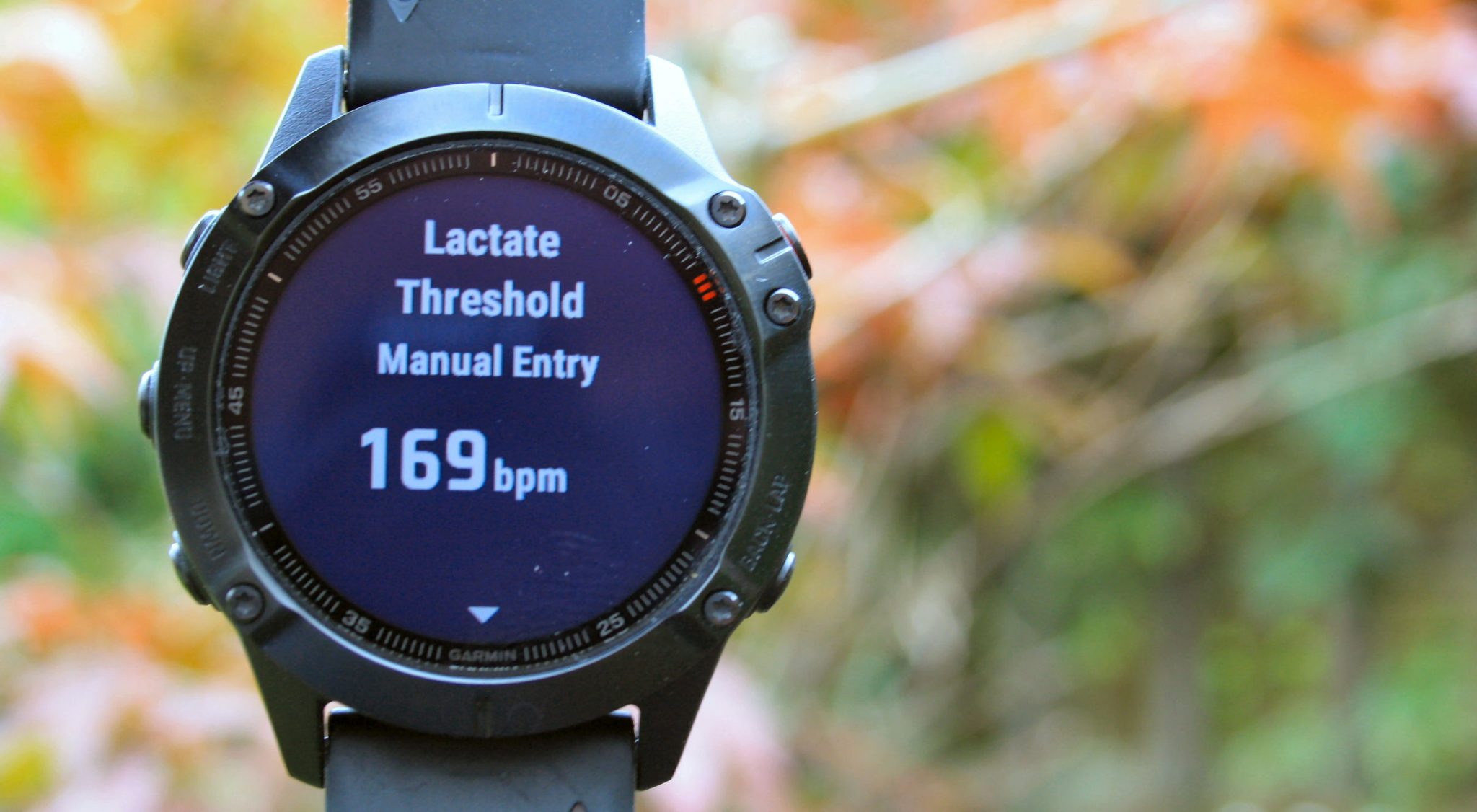 You will get a Lactate Threshold heart rate AND and Lactate Threshold pace. If you are not so fit then you might be able to maintain this for about 40 minutes but the fitter you get the longer you can maintain it for ie WELL over an hour. For me, it’s not quite my half marathon pace, if I only run-trained I reckon it would be my HM pace. I think the LTHR may be slightly over-estimated by a few BPMs based on lab tests.
You will get a Lactate Threshold heart rate AND and Lactate Threshold pace. If you are not so fit then you might be able to maintain this for about 40 minutes but the fitter you get the longer you can maintain it for ie WELL over an hour. For me, it’s not quite my half marathon pace, if I only run-trained I reckon it would be my HM pace. I think the LTHR may be slightly over-estimated by a few BPMs based on lab tests.
Don’t forget that your HR zones may well be best determined by basing them on LTHR rather than HRmax.
- Firstbeat Factette: The first Garmin device with Lactate Threshold was the Forerunner 735xt (2016)
Usefulness? 9/10. I’m a little concerned about the accuracy (looked at over the last 2 years on many devices!!). Wannabe athletes REALLY need to look at and understand AeT and AnT/LTHR. It’s fundamental for how you can perform.
Garmin FTP – An Explainer
Cyclists all know that FTP is pretty useless.
Haha. Just kidding. A whole sub-industry has been built up around FTP. I use power and FTP a LOT but don’t be taken in by the glitzy catch-all it seems to be. Read around to understand it, then Google XERT and switch on the lightbulb.
Your Functional Threshold Power (FTP) for cycling represents the highest, constant level of power that you can produce whilst not accumulating lactic acid. It’s probably NOT 60 minutes for most of us…probably less. Maybe higher for those who are well-trained. Regardless of that, we tend to say it’s your “60-minute critical power aka CP60″ and we derive power zones and other training insights from that. You can estimate your FTP in a shortened test or measure it in a lab test. Firstbeat derives estimates of FTP from your routine efforts, which is potentially less hard on your body than some of the FTP testing protocols that exist.
Usefulness? 9/10. Yes, FTP and power are super-useful. Yes, it’s great that FTP can be estimated by Firstbeat from sub-maximal efforts. No, FTP is not a panacea for world domination.
Garmin FTP – what is it? and why it’s probably not quite what you think it is
Garmin Race Time Predictor – An Explainer
There are various race predictors online which can extrapolate your performance from one distance to another. Just because you got a 5k PB with lots of anaerobic training does NOT mean that you will be able to anywhere near achieve a race predictor’s time for a marathon. This screen is unchanged compared to several models from several years ago. However, my understanding is that Garmin has moved from their own calculations behind the scenes to use those from Firstbeat which incorporate insight from trends in your Training Load, weekly mileage, and the presence of long runs in your training history. These elements combine to improve on the more traditional, less personalized predictions that rely solely on your current fitness level (VO2max) and general references regarding the sustainability of various intensity levels over time.

I’ll stick with the 645’s image as the one the Fenix 6 shows isn’t as flattering 😉 To be more honest, I would say that the newer predictions appear more accurate to me.
Usefulness? 7/10. You can probably extrapolate your 5k time to your 10k time and vice-versa. For other comparisons, this is more of a guide to what your physiology could achieve with the correct stimuli for the distance.
Calories Burned

Hey. You know what calories are. And you can see them trended in lots of exciting ways.
Usefulness? 5/10. I mean calories in-out are obviously important but…you’re a triathlete worried about training too much rather than eating too much, right?
Garmin Respiration Rates
I’ve always wanted this metric and knew it was possible YEARS ago from HRV-derived data. Now that I have it, I’m not quite sure what to do with it.

In some sports lab tests, Ventilatory Threshold (VT) is marked. Maybe there is a usefulness related to identifying VT?
Usefulness? 5/10. I mean, breathing is obviously important but….do I target a higher breathing rate or monitor it over time?
Garmin All-day Stress and Recovery
Stress can be something of a mystery, but it doesn’t have to be. The Fenix 6 features a special heart rate variability-based analysis capable of revealing the presence and intensity of the stress you experience. Checking in with this feedback will allow you to pinpoint activities, interactions, and events that produce stress in your life.
You can also see when your body is in a state of rest and recovery. This can be particularly important when looking at your overnight stress data, which will shed some light into the restorative quality of your sleep. When examining this feedback, it’s essential to understand that stress isn’t necessarily a bad thing, and experiencing stress is an important part of life. The key is to ensure that stress is offset with adequate recovery, and maintaining this balance between stress and recovery is vital to being able to benefit from the challenges you experience in life and through your activities.
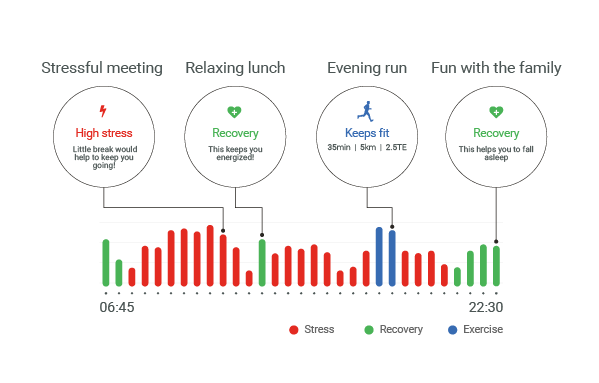
- Firstbeat Factette: The first Garmin device with All-day Stress & Recovery was the Vivosmart 3 (2016)
Usefulness? 3/10 – I guess it’s nice to know.
Garmin Quick Stress Level Test

I get stressed out just thinking about these things.
On a scale of 0-100, how stressed are you right now? high=stressed.
There’s also a related link on the watch to a quick meditation period so you can worry about de-stressing instead.
Usefulness? 3/10. Unless you are a stressed-out person, then it will stress you out some more 😉
Garmin Body Resources
 Body Battery combines All-day Stress data, physical activity, and the restorative power of sleep into a single & easily understood metaphor. Among other things, you can instantly see when a bad night’s sleep or an unusually stressful day at work will make a hard workout less beneficial than normal.
Body Battery combines All-day Stress data, physical activity, and the restorative power of sleep into a single & easily understood metaphor. Among other things, you can instantly see when a bad night’s sleep or an unusually stressful day at work will make a hard workout less beneficial than normal.
I’m not quite sure how accurate this is as I spend much of my life sitting down and then periodically getting up and doing something crazy for a few hours. So I’m a little concerned that this shows me as stressed as soon as I get out of bed. I think I’m a fairly chilled-out person.
The blue line in the chart represents your body battery or body resources. The higher it is the better prepared you are for mental and physical challenges. Overlay that with ‘stress’ and your activities then it’s certainly an interesting chart to see the interplay of these factors throughout the day

Return back to the main Garmin Fenix 6 Review
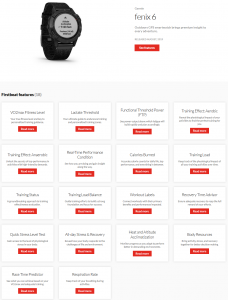



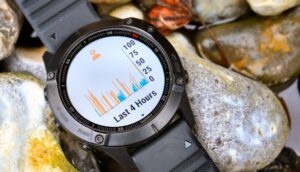



“VO2max is a relatively definitive metric of fitness. Improving it should indicate you are potentially faster but, critically, it does not take into account the economy of your technique. So we could both have a RUNNING VO2max of 60 but if your running gait is more efficient than mine then it’s very likely you’ll beat me in a 5k.”
While this is correct for true VO2max, I’m fairly certain it isn’t correct for Firstbeat estimates. Firstbeat measures the input (how hard your heart is working) and the output (how fast you’re going), but there is no way to measure the relative contribution of your VO2max and your economy to that output, so Firstbeat assumes that you have average economy. Basically it means that these estimates are more of a VDOT than a VO2max.
yup
“it does NOT take into account the economy of your technique”
Good summary – like it! Pretty much agree with all this! 🙂
What an article!
Been out of the garmin game for some time but got back in with the F6. This is the perfect refresher.
glad to be of service. I’ll test you later to make sure you read it properly.
Excellent read. Very good article of all the available information.
Thanks a lot.
The VO2 max can be good fun, as I had a 620 that was happy to write a cheque for a marathon time that my body couldn’t cash! Decided to give it a go once at Frankfurt and managed ~30k before imploding, walking for a while before having a stern talk with myself & getting back running. Finished ~8 mins slower that Mr Garmin’s prediction in the end. Possibly could have done a little better by starting slower but still an interesting exercise. My current 645 is nowhere near as optimistic, obviously has nothing to do with being five years older or lack of fitness!
I think I saw somewhere they were maybe taking into account heat to Vo2max now? Mine (F5+) tanked 5-6 points when summer hit here in Phoenix. Possible it actually decreased as I went to pure aerobic type workouts, often at hottest part of day (105-112F) but I imagine it’s because my pace slowed way down relative to a constant heart rate as I do exclusively MAF type running in summer.
yes that’s right: heat acclimation and altitude acclimitisation. https://the5krunner.com/2019/09/09/garmin-fenix-6-firstbeat-insights/
I’m speculating here: i think what FB show is your achieved VO2max equivalent, i don’t think your VO2max capacity changes too rapidly. i really wouldn’t worry about vo2max too much.
Does the chest belt you want for Lactate Threshold need to be the Garmin one or can any other HR sensor can be ok? Even the Polar OH1?
def not the oh1 but most chest straps should be ok.
Sorry, excuse my error below… firstly, a really great article. Best I’ve read on the subject. We have recently been discussing VO2max variability at home. Do you have any further insights as to why the variation? Is the number derived from the last activity or a trend? I tend to agree in that it doesn’t show increase or decrease in fitness to that level of granularity.
thank you for your kind words.
I’m not entirely sure that vendors’ VO2max actually estimate your VO2max, it’s more like the VO2max-equivalent of what you’ve just done…which isn’t the same (unless perhaps it was some kind of truly optimal effort at determining vo2max). so the reported figure can change quite a bit but it isn’t your vo2max that’s changing – admittedly over longer periods with continuous efforts, there might be something in it.
compound that with your VO2max capacity (as you the human), then that DOES decline every year as adults get older but you might never see that decline if you don’t ever operate at your maximal limit
even if your vo2max and mine are the same then, so what? if we both run you could be VERY MUCH quicker than me…like VERY. Google ‘vVO2max’
anyway, for an individual i don’t think there is much V02max variability over a week or a month (I’d have to look it up)…it’s the measurements and interpretations OF HOW CLOSE TO YOUR CAPACITY that vary IMO
Are any of Firstbeat’s metrics useful if all one does is train by run power using Stryd?
yes.
good question tho.
i guess it depends what you want to know. some of polar’s metrics incorporate bike power (would be nice to incorporate stryd power)
Ok, Currently have the Apple Watch 5 (Still in its return/refund period) and will be getting Stryd (because of your review so thanks for that!)
Main goal is to do Half Marathons (only half as I do weightlifting and don’t want to lose too much size 😉 )
Not sure if the F6 would be better for me or not. My idea is to just buy a plan on TrainingPeaks and because AW5 has great integration with TP and it gets power based alerts (audio & vibration) it seems idiot proof for an amateur like myself.
stryd has free plans..sorted
depends on how serious you wnat to be with the gadgets/toys. aw is way smarter, f6 is sport-smart with buttons (buttons are better)